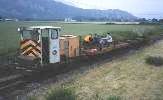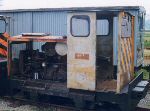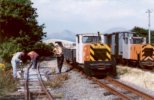Barclay 'Taxi' Diesels
Andrew Barclay Diesel Locomotives
Our two Barclay Locomotives last operated at an explosives works at Powfoot, Annan but had spent most of their working lives at ICI Explosives, Ardeer, Scotland. In all, Andrew Barclay of Kilmarnock supplied seven of this class of 2ft. 6ins. gauge machine, four were delivered in 1970 with a further three arriving the following year.
At that time, Barclay’s locomotive production had fallen to very low levels and the four machines built for ICI in 1970 apparently accounted for two thirds of that years total. The firm was in a crisis and was purchased by Hunslet between December 1970 and August 1972.
The locomotives left Ardeer and moved to Powfoot, from whence they were purchased.
Once they arrived at Porthmadog, it became apparent that the coupling castings, axle boxes and brake blocks appeared to be very similar to those used by Rustons. Further inspection revealed that they were more than similar, a number of components actually carried Ruston identification numbers, indicating the use of either original Ruston parts or patterns.
The Ardeer Works possessed a considerable number of Ruston locomotives and they seem to have been well regarded. However in 1969, shortly after it had been taken over by English Electric, Ruston had ceased to construct locomotives. One can only speculate that Ardeer turned to their local locomotive builder and asked for a design of locomotive similar to a Ruston. Presumably Barclays were then able to obtain parts or patterns from English Electric.
Although they were turned out with Ruston axle boxes and a chassis design that owes a great deal to that Company, nothing above the chassis displays any Ruston origins. Each machine has a three cylinder 30 hp Perkins engine attached to a Hunslet hydraulic transmission unit.
We had been told that when they were first constructed the locomotives had axle mounted disc brakes. On examination the remains of a disc was found on one of the axles and marks could be seen showing where the others had been. Evidently this innovation was not a success and they were later fitted with conventional brakes.
Turning to recent progress, all the wheel sets have been regauged. Both locomotives have now been restored to full working order. The original braking safety features, including the “dead man’s pedal” and parking brake were disconnected at some earlier stage in the locomotives’ history. These features have been re-instated. Freshly painted, they have become the first choice for small works trains because of their ease of use.
Both locomotives were donated by ICI.
Specifications for No. 555
| Builder | Andrew Barclay Ltd. | ||
|---|---|---|---|
| Built | 1970 | ||
| Works number | 555 | ||
| Wheel arrangement | 4 wheel | ||
| Driving wheel diameter | 17" | 444mm | |
| Engine | 30 h.p. | 22.4kW | 3 cylinder Perkin |
| Transmission | Hydraulic | ||
| Final drive | Chain | ||
| Weight | 3.5 tonne | ||
| Arrived W.H.R. | May 1993 | ||
| Owners | W.H.R. Members consortium | ||
| Previous owners | ICI Ardeer | ||
Specifications for No. 554
| Built | - | ||
|---|---|---|---|
| Works number | 554 | ||







